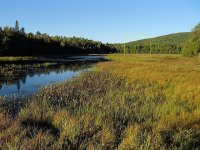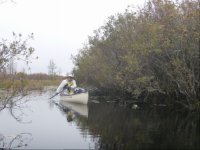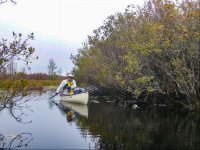My Lumix is a DMC-TS20. The issue I have could well be operator error, but I find too many photos just look washed out, which I think means over exposed. Like this one:
Yes it was an overcast day, but the vegetation should be a more vibrant color and nothing is very sharp.
Image sharpness in pix taken should be sharp enough for viewing on a computer monitor... I agree that the camera isn't a high-end waterproof and probably it's time for an upgrade... still, looking at the DMC-TS20 test pix on the review page below shows that sharpness is good enough for viewing on a screen... more detail in the magnified views than in the full frame. To see this, look for test photos with fine details that test the capability of the lens resolution, on the edge of the camera's capability to resolve... distant branches, brick walls, signs.... fine detail that becomes visible when magnified, but disappears when the image size is reduced back down so that the full framing appears. This should show that the camera is recording finer detail than what appears on the monitor, so this camera's sharp enough for that purpose.
http://www.steves-digicams.com/camer...hotos-177.html
An example, here's a little test I did with my Olympus TG-820 with a photo that has lots of fine detail... in the first full frame view, the rectangular hunting blind in the yellow outtline is barely visible, just a dot. In the blown-up portion, the rectangular detail shows up and the structure is recognizable as a duck blind. Looking closely and magnified, there's more detail captured in the camera's image than what shows in the entire photo on the monitor. It's sharp enough.


(PS... the above photos haven't had anything done in post-production (except for adding the yellow box outline) and they're too blue from all the skylight. That needs to be reduced by warming the image up by adjusting color balance and maybe some change to brightness and contrast as well.)
You might want to test your camera for sharpness with some similarly detailed subjects, to compare to the review photos in the link and see if your photos match their quality.
The high-contrast photo you posted lacking sharpness in the leaves against the bright sky might be a result of bright light fringing around the edges of the leaves, making them look fuzzy, which can be a problem with the small point-and-shoot cameras. Try a lower contrast scene and maybe the sharp detail will be there. Or maybe more likely the camera wasn't allowed time to focus, might not be focusing quickly enough, or the focus setting might need to be changed (not familiar with Panasonic settings menu). Test to see if the camera's focussing on detail OK.
Lack of color brightness could be affected by the image processor in your camera... Olympus image processors produce contrasty, bright colors and have been criticized for being too bright (ie. not an accurate rendering of the scene). Panasonic image processor color seems to be more muted and for some may be more realistic or for others too muted, so increasing the color saturation, modifying contrast, brightness and color balance in post-production might help (Panasonic may have provided a disc for that with the camera).
Try some tests, they might show something better than what you've shown above. OTOH, also time for an upgrade if you want something better, enjoy the search, more reviews on new gear will be coming for sure.




